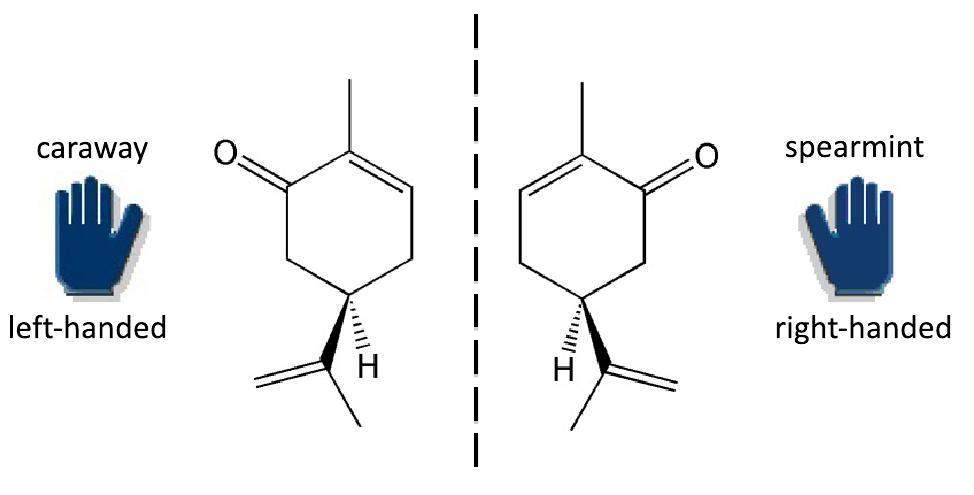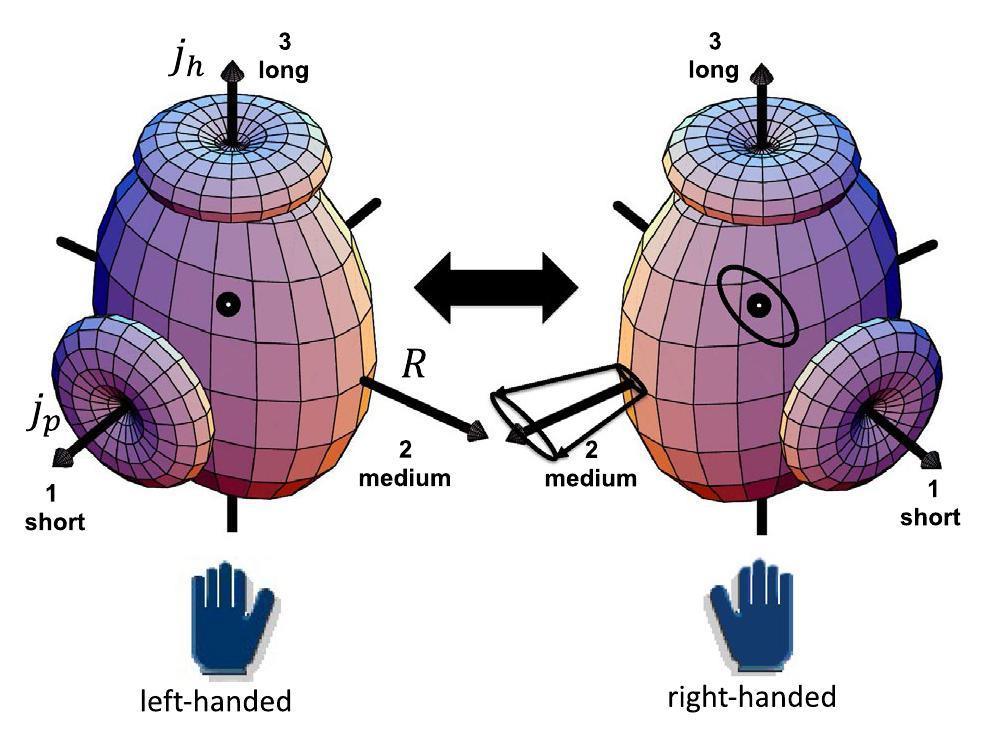Chirality (Greek "handiness") is a property of many complex molecules. Chiral molecules exist in two forms, one being the mirror image of the other. Like for our hands, it is impossible to make the images identical by a suitable rotation. The two forms are called left-handed and right-handed. They have the same binding energy, because the electromagnetic interaction, which holds the molecule together, does not change under a reflection. Other properties that are insensitive to the geometry are also the same. The different geometry is the reason why the left-handed form turns the polarization plane of transmitted light in one direction by some angle while the right-handed form turns it in the opposite direction by the same angle. However, the geometrical differences between the two species may have other consequences. The two species of the carvon molecule shown in Fig. 1 taste quite differently.

In contrast to molecules, nuclei are very compact. They resemble deformed droplets of liquid, with nearly constant interior density and a thin surface, which reflects the short range of the interaction that keeps the nucleons together. The shapes are simple: spherical, axial symmetric, mostly football-like, sometimes pear-shaped. Some nuclei take the shape of a triaxial ellipsoid. Such simple shapes do not attain the property of chirality, which was considered as an alien concept by nuclear physicists. Surprisingly, the studies of the rotational excitations of triaxial nuclei have revealed that they may attain chirality [1].
Deformed nuclei exhibit rotational spectra similar to molecules. These rotational bands are regular sequences of states with quantized energy and angular momentum differing solely in their rotational velocity. Concerning the dynamics of rotation, molecules behave like classical bodies while nuclei behave like a quantum liquid. In even-even nuclei, the rotational dynamics necessitate that the triaxial shape deviates from rotational symmetry with respect to a principal axis in order to facilitate rotation around it. The corresponding moments of inertia increase with the asymmetry of the shape with respect to the axis. As illustrated by the triaxial shape in Fig. 2, the asymmetry is maximal for the medium (m-) axis and so the moment of inertia. Therefore rotation about the m-axis generates the lowest (yrast) rotational band. Only even values of the angular momentum R appear because for a quantum liquid of indistinguishable constituents a rotation by the angle of π leads to an identical state, which restricts the possible values of R to even.

In triaxial nuclei, excited rotational bands appear when the angular momentum vector
A new pattern evolves when not all the angular momenta
The presence of the high-j orbitals dramatically changes the rotational behavior. As they act like gyroscopes, the nucleus becomes a clockwork of gyroscopes, which can rotate about an axis that is tilted away from one of the principal axes of the shape.
When there is only one particle on a high-j orbital the total angular momentum is
When in odd-odd nuclei an odd high-j proton is combined with an odd high-j neutron hole (or vice versa), the total angular momentum
The tilt of
There is some coupling between the left- and right-handed configurations which perturbs the ideal pattern. The energies of the chiral partners are somewhat different and so are the γ emission pattern. The consequences of the left-right coupling are discussed in Ref. [2] as part of an introduction to nuclear chirality in the style of this comment. Chiral partner bands have been identified in the mass regions around A= 80, 110, 130, 190. The evidence has been recently reviewed by Meng [5].
The precession of
Figure 3 shows the new level scheme constructed by means of the cutting-edge experiment. As usual, the levels are arranged into rotational bands based on the strong Δ I=2 E2 and Δ I=1 mixed E2-M1 transitions. B1 constitutes the Δ I=1 yrast band characteristic for rotation about the tilted axis. B2 is assigned to the Δ I=1 chiral partner at somewhat higher energy. The shift reflects the left-right coupling. The assignment is supported by the dominant M1 character of the Δ I=1 transitions within and between the partner bands, which stagger with opposite phase. B3 constitutes one of the chiral wobbling bands. The assignment is established by the enhanced Δ I=1 E2 transition probabilities to B1.

Calculations using a model which couples a triaxial rotor with a proton h11/2 hole and a h11/2 neutron particle well reproduce the observed energies and transition probabilities. They support in a quantitive way the discussion of chiral partner bands and chiral wobbling given above.
The discovery of the chiral wobbling band in Ref. [6] revealed a new facet of the exotic rotation modes of triaxial nuclei. Moreover, the work affirmed the existence of chirality in the A=80 mass region.
Tilted rotation of triaxial nuclei
. Nucl. Phys. A 617, 131-147 (1997). https://doi.org/10.1016/S0375-9474(97)00004-3Transverse wobbling: A collective mode in odd-A triaxial nuclei
. Phys. Rev. C 89, 014322 (2014). https://doi.org/10.1103/PhysRevC.89.014322Spontaneous symmetry breaking in rotating nuclei
. Rev. Mod. Phys. 73, 463 (2001). https://doi.org/10.1103/RevModPhys.73.463Evidence for chiral wobbler in nuclei
. Phys. Rev. Lett. 132, 092501 (2024). https://doi.org/10.1103/PhysRevLett.132.092501

